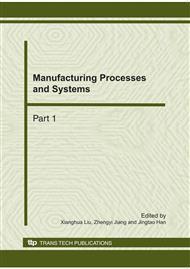[1]
D.J. Thompson: A continuous damped vibration absorber to reduce broad-band wave propagation in beams. Journal of sound and vibration, Vol. 311(2008), pp.824-842.
DOI: 10.1016/j.jsv.2007.09.038
Google Scholar
[2]
Felipe Antonio Chegury Viana, etc: Tuning dynamic vibration absorbers by using ant colony optimization . computer &structure, Vol. 86(2008), pp.1539-1549.
DOI: 10.1016/j.compstruc.2007.05.009
Google Scholar
[3]
Rahul Rana and T. T. Soong: Parametric study and simplified design of tuned mass dampers. Engineering Structures, Vol20. (1998) , pp.193-204.
DOI: 10.1016/s0141-0296(97)00078-3
Google Scholar
[4]
Philip D. Cha, Michael Chan: Mitigating Vibration Along an Arbitrarily Supported Elastic Structure Using Multiple Two-Degree-of-Freedom Oscillators. Journal of vibration and acoustics, Vol. 131(2009), , 031008.
DOI: 10.1115/1.3085891
Google Scholar
[5]
J.C. Snowdon, A.A. Wolfe,; indR . L. Keriin: The cruciform dynamic vibration absorber. J. Acoust. Soc,A. m, Vol. 75(1984), , pp.1792-1799.
Google Scholar
[6]
Eiichi Nishida, G. H. Koopmann: A Method for Designing and Fabricating Broadband Vibration Absorbers for Structural Noise Control. Journal of vibration and acoustics, Vol. 129(2007), pp.397-405.
DOI: 10.1115/1.2424968
Google Scholar
[7]
G. Pavic: Numerical study ofdamping, energy and energ vibration y flow in a beam–plate system. Journal of Sound and Vibration, Vol . 291(2006), , p.902–931.
DOI: 10.1016/j.jsv.2005.07.020
Google Scholar
[8]
Goyder H G D,White R G: vibration power flow from machines into built-up structure, Part I. Vol. 68(1980), p. l57-117.
DOI: 10.1016/0022-460x(80)90454-x
Google Scholar
[9]
Y.P. Xiong, J.T. Xing, W.G. Price: Power flow analysis of complex coupled systems by progressive approaches, Journal of Sound and Vibration, Vol. 239(2001), p.275–295.
DOI: 10.1006/jsvi.2000.3159
Google Scholar
[10]
M. Febbo S. A. Vera: Optimization of a Two Degree of Freedom System Acting as a Dynamic Vibration Absorber. Journal of vibration and acoustics, Vol. 130 (2008): 011013.
DOI: 10.1115/1.2827368
Google Scholar
[11]
W.O. Wong_, Y.L. Cheung: Optimal design of a damped dynamic vibration absorber for vibration control of structure excited by ground motion. Engineering Structure, Vol. 30(2008), pp.282-286.
DOI: 10.1016/j.engstruct.2007.03.007
Google Scholar
[12]
Weilin Du, Bin Li: Multi-strategy ensemble particle swarm optimization for dynamic optimization . Information Sciences, Vol, 178(2008), p.3096–3109.
DOI: 10.1016/j.ins.2008.01.020
Google Scholar
[13]
L.J. Li , Z.B. Huang, F. Liu: A heuristic particle swarm optimization method for truss structures with discrete variables. Computers and Structures, Vol, 87(2009), p.435–443.
DOI: 10.1016/j.compstruc.2009.01.004
Google Scholar
[14]
Y.K. Koh R.G. White: analysis and control of vibrational power transmission to machinery supporting structures subjected to a multi-excitation system, PartⅡ[J]. Journal of sound and vibration, Vol. 196(1996) , pp.495-508.
DOI: 10.1006/jsvi.1996.0497
Google Scholar
[15]
Z.H. Wang, J.T. Xing, W.G. Price: A study of power flow in a coupled plate–cylindrical shell system. Journal of Sound and Vibration, Vol. 271(2008), p.863–882.
DOI: 10.1016/s0022-460x(03)00757-0
Google Scholar
[16]
L. Cremer,M. Heckl: Structure-Brone Sound, springer, NY(1996), second edition.
Google Scholar
[17]
. zdemir, M.O. Kaya, Flabse: Bending Vibration Analysis of Rotating Tapered Cantilever Bernoulli–Euler Beam by Differential Transform Method, Journal of Sound and Vibration, Vol. 289(2006), p.413–420.
DOI: 10.1016/j.jsv.2005.01.055
Google Scholar
[18]
J.M. Cuschieri: Parametric analysis of the power flow on an L-shaped plate using a mobility power flow approach.J. Acoust. Soc. Am. Vol. 19(1992) , pp.2686-2695.
DOI: 10.1121/1.402976
Google Scholar
[19]
Frank Fahy, Paolo Gardonio. Sound and Vibration, Elsevier, NY(2007), second edition.
Google Scholar
[20]
Y.L. Cheung, W.O. Wong: H∞and H2 optimizations of a dynamic vibration absorber for suppressing vibrations in plates . Journal of sound and vibration. Vol, 320(2009), pp.29-42.
DOI: 10.1016/j.jsv.2008.07.024
Google Scholar
[21]
R.C. Eberhart:J. Kennedy, A new optimizer using particle swarm theory, Proceedings of the Sixth International Symposium on Micromachine and Human Science, Nagoya, Japan (1995), p.39–43.
DOI: 10.1109/mhs.1995.494215
Google Scholar
[22]
Rajamohan Ganesan, Abolghassem Zabihollah: Vibration analysis of tapered composite beams using a higher-order finite element. Part II: parametric study. Composite Structures, Vol. 77(2007), p.319–330.
DOI: 10.1016/j.compstruct.2005.07.017
Google Scholar


